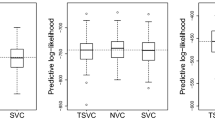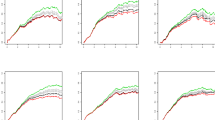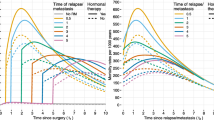Abstract
Research on methods for studying time-to-event data (survival analysis) has been extensive in recent years. The basic model in use today represents the hazard function for an individual through a proportional hazards model (Cox, 1972). Typically, it is assumed that a covariate's effect on the hazard function is constant throughout the course of the study. In this paper we propose a method to allow for possible deviations from the standard Cox model, by allowing the effect of a covariate to vary over time. This method is based on a dynamic linear model. We present our method in terms of a Bayesian hierarchical model. We fit the model to the data using Markov chain Monte Carlo methods. Finally, we illustrate the approach with several examples.
Similar content being viewed by others
References
O.O. Aalen, “Nonparametric inference for a family of counting processes,” Annals of Statistics 6, 701–726, 1978.
H. Akaike, “Information theory and an extension of the entropy maximization principle”, in Proceedings of the Second International Symposium on Information Theory, eds. B.N. Petrov and R. Csak. Kiado: Akademica, 1973.
P.K. Anderson and R.D. Gill, “Cox's regression model for counting processes: A large sample study,” Annals of Statistics 10, 1100–1120, 1982.
D.R. Cox, “Regression models and life tables (with discussion),” Journal of the Royal Statistical Society, Series B 34, 187–220, 1972.
D.R. Cox, “Partial Likelihood,” Biometrika 62, 269–275, 1975.
B. Efron, “The efficiency of Cox's likelihood function for censored data,” Journal of the American Statistical Association 72, 557–565, 1977.
D. Gamerman, “Dynamic Bayesian models for survival data,” Applied Statistics 40, 63–79, 1991.
A.E. Gelfand and A.F.M. Smith, “Sampling based approaches to calculating marginal densities,” Journal of the American Statistical Association 85, 398–409, 1990.
A. Gelman, G. Roberts, W. Gilks, “Efficient Metropolis jumping rules,” in Bayesian Statistics 5, eds. J.O. Berger, J.M. Bernardo, A.P. Dawid, A.F.M. Smith, Oxford: University Press, 1996.
A. Gelman and D.B. Rubin, “Inference from iterative simulation using multiple sequences (with discussion),” Statistical Science 7, 457–511, 1992.
I.J. Good and R.A Gaskins, “Density estimation and bump-hunting by the penalized likelihood method exemplified by scattering and meteorite data (with discussion),” Journal of the American Statistical Association 75, 42–56, 1980.
P.M. Grambsch and T.M. Therneau, “Proportional hazards tests and diagnostics based on weighted residuals,” Biometrika 81, 515–526, 1994.
R.J. Gray, “Flexible methods for analyzing survival data using splines, with applications to breast cancer prognosis,” Journal of the American Statistical Association 87, 942–951, 1992.
R.J. Gray, “Spline-based tests in survival analysis,” Biometrics 50, 640–652, 1994.
T.J. Hastie and R.J. Tibshirani, Generalized additive models, New York: Chapman and Hall, 1990.
T.J. Hastie and R.J. Tibshirani, “Varying-coefficient models,” Journal of the Royal Statistical Society, Series B 55, 86-95, 1993.
S. Johansen, “An extension of Cox's regression model,” International Statistical Review, 51, 165-174, 1983.
J.D. Kalbfleisch, “Nonparametric Bayesian analysis of survival time data,” Journal of the Royal Statistical Society, Series B 40, 214–221, 1978.
J.D. Kalbfleisch and R.L. Prentice, The Statistical Analysis of Failure Time Data. New York: Wiley, 1978.
D.Y. Lin, “Goodness-of-fit for the Cox regression model based on a class of parameter estimators,” Journal of the American Statistical Association 86, 725–728, 1991.
D.V. Lindley and A.F.M Smith, “Bayes estimates for the linear model (with discussion),” Journal of the Royal Statistical Society, Series B, 34, 1–41, 1972.
P. Müller, “A generic approach to posterior integration and Gibbs sampling,” Technical Report 91-009, Department of Statistics, Purdue University.
F. O'sullivan, “Nonparametric estimation in the Cox model,” The Annals of Statistics 21, 124–145, 1993.
D.J. Sargent, “A general framework for random effects survival analysis in the Cox proportional hazards setting,” Research Report 95–004, Division of Biostatistics, University of Minnesota, 1995.
D. Schoenfeld, “Partial residuals for the proportional hazards regression model,” Biometrika 69, 239–241, 1982.
A.F.M. Smith and G.O. Roberts, “Bayesian computation via the Gibbs sampler and related Markov chain Monte Carlo methods (with discussion),” Journal of the Royal Statistical Society, Series B 55, 3–23, 1993.
T.M. Therneau, “A package of survival functions for S,” Technical Report No. 53, Section of Biostatistics, Mayo Clinic, 1994.
L. Tierney, “Markov chains for exploring posterior distributions (with discussion),” Annals of Statistics 22, 1701–1762, 1994.
P.J.M. Verweij and H.C. van Houwelingen, “Time-dependent effects of fixed covariates in Cox regression,” Biometrics 51 1550–1556, 1995.
M. West, P.J. Harrison, H.S. Migon, “Dynamic generalized linear models and Bayesian forecasting (with discussion),” Journal of the American Statistical Association 80, 73–97, 1985.
D.M. Zucker and A.F. Karr, “Nonparametric survival analysis with time-dependent covariate effects: a penalized partial likelihood approach,” The Annals of Statistics 18, 329–353, 1990.
Author information
Authors and Affiliations
Rights and permissions
About this article
Cite this article
Sargent, D.J. A Flexible Approach to Time-varying Coefficients in the Cox Regression Setting. Lifetime Data Anal 3, 13–25 (1997). https://doi.org/10.1023/A:1009612117342
Issue Date:
DOI: https://doi.org/10.1023/A:1009612117342




